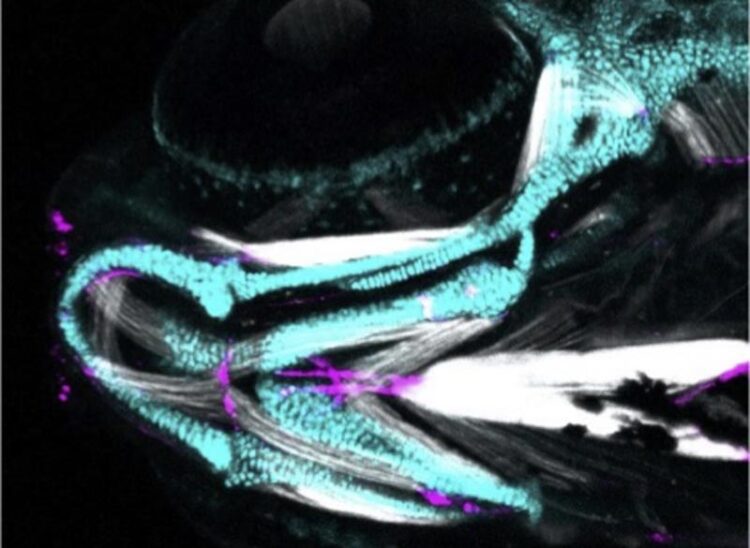How to assemble a complete jaw

One-week-old zebrafish with jaw cartilage in blue, tendons in magenta and jaw muscles in white.
Credit: Hung-Jhen (Olivia) Chen, Crump Lab
A USC-led team of scientists has made a drool-worthy discovery about how tendons and salivary glands develop in the jaw. Their results are published in a new study in Developmental Cell.
In order for our jaws to function, they require not only a precisely patterned skeleton, but also tendons that connect the jaw skeleton to muscles and salivary glands that lubricate the mouth. Remarkably, the skeleton, tendons, and glands all derive from the same population of stem cells, which arise from a cell population known as neural crest. How these neural crest-derived cells know to make the right type of cell in the right location has remained a mystery.
To begin answering this question, first author Hung-Jhen (Olivia) Chen from the lab of corresponding author Gage Crump, professor and vice-chair of stem cell biology and regenerative medicine at the Keck School of Medicine of USC, and colleagues examined all the genes that were active in the developing face of zebrafish. They then honed in on one particular gene, Nr5a2, that was active in a region of the face that makes tendons and glands, but not skeleton.
To understand the role of Nr5a2, the scientists created zebrafish lacking this gene. These mutant zebrafish generated excess cartilage and were missing tendons in their jaws.
The scientists also developed mice lacking this gene specifically in their neural crest cells. These mice not only had skeletal and tendon defects in their jaws, but also failed to develop salivary glands. Similar defects were also seen in the middle ear, reflecting a dramatic evolutionary transition in which part of the fish jaw became the mammalian middle ear.
To clarify how this was happening, the scientists examined the structure of the genome in zebrafish lacking Nr5a2. They found that Nr5a2 was essential for opening up regions of the genome that enable neural crest cells to maintain their stem cell features, while at the same time priming these cells to form tendons and salivary glands later in jaw development.
“Discovery of a very specific role of Nr5a2 in jaw patterning was unexpected, as this gene had previously been shown to be essential for maintaining embryonic stem cells,” said Crump. “Our work shows how a key stem cell factor can be used in a different way later in development to control how diverse cell types are made.”
Additional co-authors include Lindsey Barske, who completed her postdoctoral training at USC and is now a faculty member at Cincinnati Children’s Hospital Medical Center; Jared Talbot from the University of Maine; Olivia Dinwoodie and Abigail Tucker from King’s College London; Ryan Roberts, Christian Jimenez, and Amy Merrill from USC; and D’Juan Farmer who completed his postdoctoral training at USC and is now a faculty member at UCLA.
Funding for this research was provided by the National Institute of Dental Craniofacial Research (grants R21DE029656 and R35DE027550), the Howard Hughes Medical Institute’s Hannah H. Gray Fellows Program, and the King’s College London Medical Research Council Doctoral Training Partnership.
Journal: Developmental Cell
DOI: 10.1016/j.devcel.2023.02.011
Method of Research: Experimental study
Subject of Research: Animals
Article Title: Nuclear Receptor Nr5a2 Promotes Diverse Connective Tissue Fates in the Jaw
Article Publication Date: 10-Mar-2023
Media Contact
Laura LeBlanc
Keck School of Medicine of USC
laura.leblanc@med.usc.edu
Cell: 646-825-0821
All latest news from the category: Life Sciences and Chemistry
Articles and reports from the Life Sciences and chemistry area deal with applied and basic research into modern biology, chemistry and human medicine.
Valuable information can be found on a range of life sciences fields including bacteriology, biochemistry, bionics, bioinformatics, biophysics, biotechnology, genetics, geobotany, human biology, marine biology, microbiology, molecular biology, cellular biology, zoology, bioinorganic chemistry, microchemistry and environmental chemistry.
Newest articles

High-energy-density aqueous battery based on halogen multi-electron transfer
Traditional non-aqueous lithium-ion batteries have a high energy density, but their safety is compromised due to the flammable organic electrolytes they utilize. Aqueous batteries use water as the solvent for…

First-ever combined heart pump and pig kidney transplant
…gives new hope to patient with terminal illness. Surgeons at NYU Langone Health performed the first-ever combined mechanical heart pump and gene-edited pig kidney transplant surgery in a 54-year-old woman…

Biophysics: Testing how well biomarkers work
LMU researchers have developed a method to determine how reliably target proteins can be labeled using super-resolution fluorescence microscopy. Modern microscopy techniques make it possible to examine the inner workings…





















